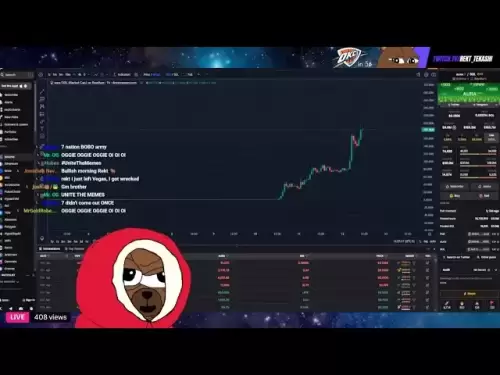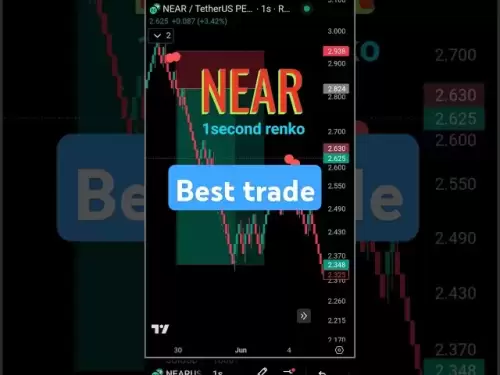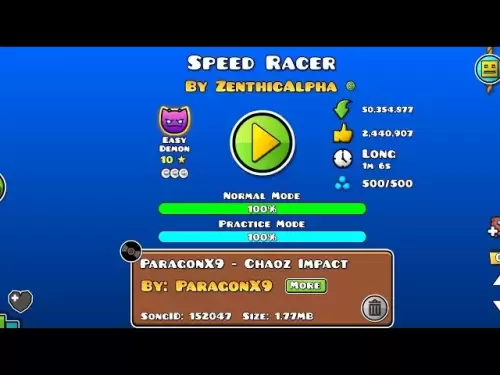-
 Bitcoin
Bitcoin $105,288.6945
-2.61% -
 Ethereum
Ethereum $2,546.9059
-7.84% -
 Tether USDt
Tether USDt $1.0004
0.05% -
 XRP
XRP $2.1438
-4.68% -
 BNB
BNB $653.2251
-1.80% -
 Solana
Solana $146.3449
-8.07% -
 USDC
USDC $0.9997
0.01% -
 Dogecoin
Dogecoin $0.1778
-5.94% -
 TRON
TRON $0.2688
-2.27% -
 Cardano
Cardano $0.6373
-7.04% -
 Hyperliquid
Hyperliquid $41.2776
-4.37% -
 Sui
Sui $3.0223
-9.71% -
 Chainlink
Chainlink $13.3280
-7.77% -
 Bitcoin Cash
Bitcoin Cash $430.6921
-2.12% -
 UNUS SED LEO
UNUS SED LEO $9.0426
1.98% -
 Avalanche
Avalanche $19.2275
-8.92% -
 Stellar
Stellar $0.2600
-5.55% -
 Toncoin
Toncoin $2.9984
-6.13% -
 Shiba Inu
Shiba Inu $0.0...01195
-5.71% -
 Hedera
Hedera $0.1566
-7.37% -
 Litecoin
Litecoin $84.6896
-5.28% -
 Polkadot
Polkadot $3.8188
-6.28% -
 Ethena USDe
Ethena USDe $1.0004
0.00% -
 Monero
Monero $311.9801
-3.66% -
 Dai
Dai $0.9998
0.00% -
 Bitget Token
Bitget Token $4.5149
-4.09% -
 Uniswap
Uniswap $7.4602
-6.13% -
 Pepe
Pepe $0.0...01088
-11.16% -
 Aave
Aave $280.9076
-8.02% -
 Pi
Pi $0.5699
-8.88%
Three consecutive positives at low positions and mild volume: Is the main force building a position?
Three consecutive positive closes at low positions with mild volume may signal the main force quietly building a position in cryptocurrency markets.
Jun 12, 2025 at 06:42 am
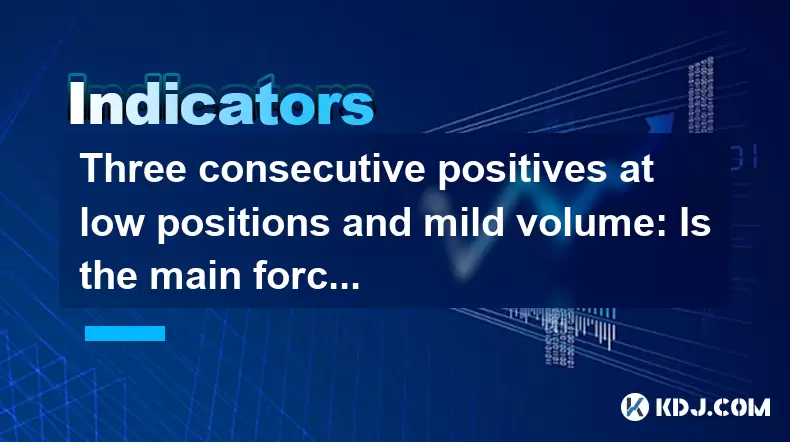
In the world of cryptocurrency trading, understanding the behavior of the main force or the big players in the market is crucial for making informed decisions. One of the patterns that traders often look for is three consecutive positives at low positions with mild volume. This pattern can be indicative of the main force building a position. Let's delve into what this means and how to interpret it.
Understanding Three Consecutive Positives at Low Positions
Three consecutive positives refer to a scenario where the price of a cryptocurrency closes higher than the previous day's close for three days in a row. When this occurs at low positions, it means that the price is still relatively low compared to recent highs. This pattern, combined with mild volume, suggests that there is a gradual increase in buying interest without causing a significant spike in trading volume.
The Role of Mild Volume
Mild volume is a critical component of this pattern. If the volume were to spike significantly during these three consecutive positive days, it might indicate a short-term surge in buying interest that could be unsustainable. However, mild volume suggests that the buying is steady and controlled, which could be a sign of the main force quietly accumulating the cryptocurrency without drawing too much attention.
How the Main Force Builds a Position
The main force, or institutional investors, often builds positions over time to avoid causing a sudden spike in price that could alert other market participants. They typically do this by:
- Buying in small increments: This helps to keep the price movement gradual.
- Using limit orders: These allow them to buy at specific price levels without immediately impacting the market.
- Trading during low liquidity periods: This can include off-hours or times when fewer traders are active.
By employing these strategies, the main force can accumulate a significant position without causing a noticeable increase in price or volume.
Identifying the Pattern on Charts
To identify this pattern, traders need to analyze price charts and volume data. Here’s how you can do it:
- Select a reliable charting platform: Platforms like TradingView or Coinigy provide detailed price and volume data.
- Set the time frame: Daily charts are often used to identify this pattern, but you can also use shorter time frames like 4-hour or 1-hour charts for more granular analysis.
- Look for three consecutive green candles: These indicate that the closing price was higher than the opening price for three days in a row.
- Check the position of these candles: They should be at a relatively low point compared to recent highs.
- Analyze the volume: Ensure that the volume during these three days is not significantly higher than the average volume over the past few weeks.
Case Studies and Examples
Let’s look at a couple of hypothetical examples to illustrate how this pattern might play out in the real world.
Example 1: Bitcoin (BTC)
Imagine that Bitcoin has been trading sideways for a few weeks, with its price ranging between $25,000 and $27,000. Suddenly, over the course of three days, the price closes at $25,200, $25,500, and $25,800, respectively. The volume during these three days remains relatively stable compared to the average volume over the past month. This could be a sign that the main force is quietly building a position in Bitcoin at these low levels.
Example 2: Ethereum (ETH)
Ethereum has been experiencing a downtrend, with prices dropping from $2,000 to $1,800 over a month. Over the next three days, the price closes at $1,820, $1,840, and $1,860, with volume remaining mild. This pattern could suggest that the main force is starting to build a position in Ethereum, anticipating a potential reversal.
Risks and Considerations
While the pattern of three consecutive positives at low positions with mild volume can be a strong indicator of the main force building a position, it is not foolproof. Traders should consider the following risks and considerations:
- False signals: Sometimes, this pattern can occur due to random market movements and not due to the main force's actions.
- Market sentiment: Broader market sentiment and news can quickly change the direction of the price, regardless of the main force's actions.
- Technical analysis limitations: Technical analysis, including this pattern, should be used in conjunction with other indicators and fundamental analysis for a more comprehensive view.
Using the Pattern in Trading Strategies
Traders can incorporate this pattern into their trading strategies by:
- Setting entry points: Once the pattern is identified, traders can set entry points just above the third positive close to capitalize on the potential upward movement.
- Managing risk: Using stop-loss orders to protect against sudden reversals can help manage risk.
- Monitoring volume: Continuously monitoring volume can help confirm whether the pattern is indeed driven by the main force or if it's a false signal.
Conclusion
Understanding the pattern of three consecutive positives at low positions with mild volume can provide valuable insights into the actions of the main force in the cryptocurrency market. By recognizing this pattern and using it as part of a broader trading strategy, traders can potentially improve their decision-making process and increase their chances of success.
Frequently Asked Questions
What other patterns should I look for to confirm that the main force is building a position?
In addition to the pattern of three consecutive positives at low positions with mild volume, traders should look for other signs such as bullish divergence on the RSI (Relative Strength Index), ascending triangles on the price chart, and increasing open interest in futures markets. These additional indicators can provide further confirmation that the main force is indeed accumulating a position.
How can I differentiate between the main force building a position and a general market recovery?
Differentiating between the main force building a position and a general market recovery can be challenging. One way to do this is by analyzing the volume. If the volume remains mild during the price increase, it could be a sign of the main force quietly accumulating. In contrast, a general market recovery often involves higher volume as more traders participate. Additionally, looking at the behavior of other cryptocurrencies can help; if only a specific cryptocurrency is showing this pattern, it might be more indicative of the main force's actions.
Can this pattern be used in other financial markets besides cryptocurrencies?
Yes, the pattern of three consecutive positives at low positions with mild volume can be applied to other financial markets such as stocks, forex, and commodities. However, the interpretation and effectiveness may vary depending on the specific characteristics of each market. For example, in the stock market, additional factors like earnings reports and regulatory news can influence the pattern's reliability.
What are some common mistakes traders make when interpreting this pattern?
One common mistake is over-reliance on a single pattern. Traders should use this pattern in conjunction with other technical and fundamental indicators to avoid false signals. Another mistake is ignoring the broader market context, such as overall market trends and sentiment, which can significantly impact the effectiveness of the pattern. Lastly, failing to set proper risk management measures, like stop-loss orders, can lead to significant losses if the pattern does not play out as expected.
Disclaimer:info@kdj.com
The information provided is not trading advice. kdj.com does not assume any responsibility for any investments made based on the information provided in this article. Cryptocurrencies are highly volatile and it is highly recommended that you invest with caution after thorough research!
If you believe that the content used on this website infringes your copyright, please contact us immediately (info@kdj.com) and we will delete it promptly.
- Bitwise CEO Predicts Bitcoin Holders Will Stop Selling Once Price Surpasses $130,000
- 2025-06-14 01:30:12
- Neo Pepe’s Revolution Begins
- 2025-06-14 01:30:12
- Aptos (APT) Token Unlock – June 12, 2025
- 2025-06-14 01:25:12
- Aptos (APT) Token Unlock – June 12, 2025
- 2025-06-14 01:25:12
- Ruvi AI Emerges as a Potential Rival to Cardano (ADA)
- 2025-06-14 01:20:12
- Market Capitalization Often Confuses Casual Investors, and Detractors Have Weaponized It Against Bullish XRP Price Predictions
- 2025-06-14 01:20:12
Related knowledge
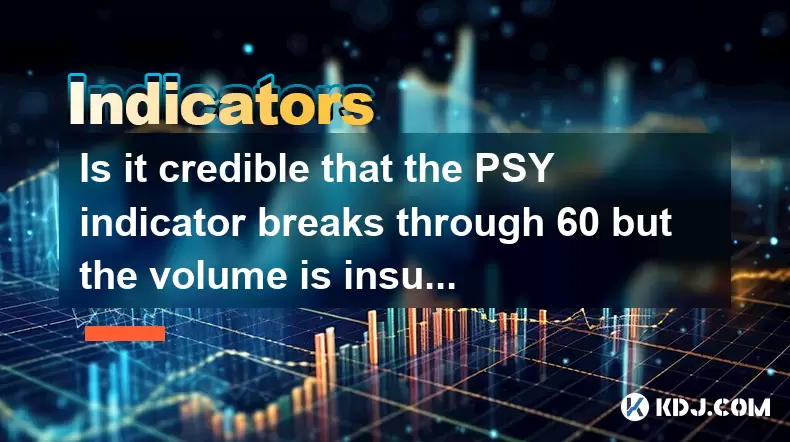
Is it credible that the PSY indicator breaks through 60 but the volume is insufficient?
Jun 14,2025 at 12:14am
Understanding the PSY Indicator in Cryptocurrency TradingThe Psychological Line (PSY) indicator is a momentum oscillator used primarily to measure the sentiment of traders and investors in financial markets, including the cryptocurrency space. It calculates the ratio of days where prices closed higher versus lower over a specified period, typically 12 o...
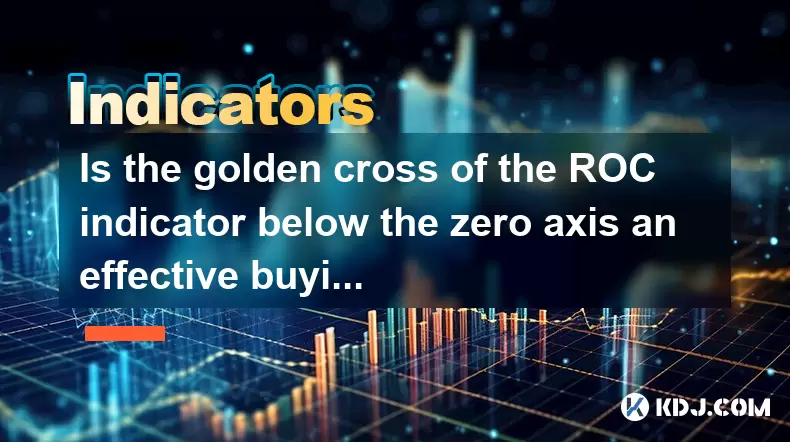
Is the golden cross of the ROC indicator below the zero axis an effective buying point?
Jun 14,2025 at 01:29am
Understanding the ROC Indicator and Its SignificanceThe Rate of Change (ROC) indicator is a momentum oscillator used in technical analysis to measure the percentage change in price between the current closing price and the closing price from a set number of periods ago. This tool helps traders assess the speed at which prices are changing, offering insi...

Will the RSI fall after the top divergence? How to improve the judgment accuracy?
Jun 13,2025 at 11:21pm
Understanding RSI and Top Divergence in Cryptocurrency TradingThe Relative Strength Index (RSI) is a momentum oscillator widely used in cryptocurrency trading to measure the speed and change of price movements. It typically ranges from 0 to 100, with levels above 70 considered overbought and below 30 considered oversold. In crypto markets, where volatil...
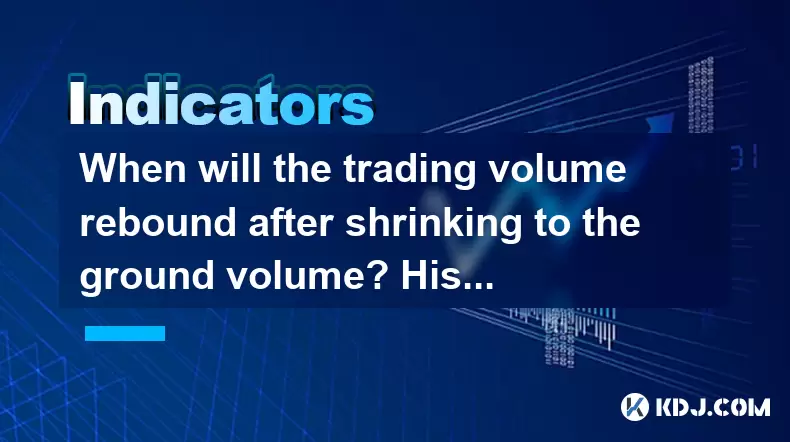
When will the trading volume rebound after shrinking to the ground volume? Historical percentile comparison method
Jun 13,2025 at 03:36pm
Understanding the Ground Volume Concept in Cryptocurrency MarketsIn cryptocurrency trading, 'ground volume' refers to a period when the trading volume of a particular asset or market drops significantly, often reaching multi-month or even multi-year lows. This phenomenon typically signals a lack of interest from traders and investors, suggesting that th...
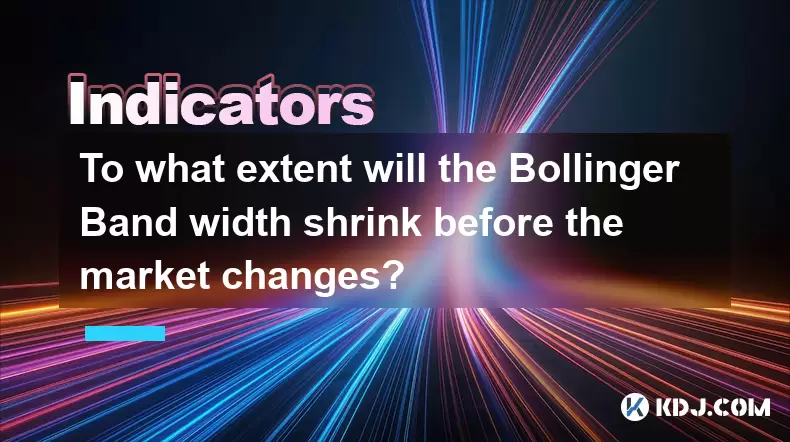
To what extent will the Bollinger Band width shrink before the market changes?
Jun 13,2025 at 06:35pm
Understanding the Bollinger Band Width and Its SignificanceThe Bollinger Band width is a critical technical analysis tool used in cryptocurrency trading to measure market volatility. It consists of three lines: a simple moving average (SMA), an upper band, and a lower band. The distance between the upper and lower bands reflects the level of volatility ...
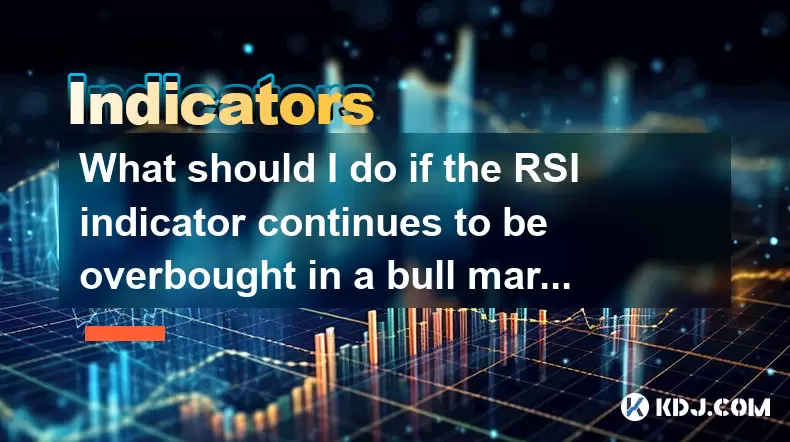
What should I do if the RSI indicator continues to be overbought in a bull market? How to adjust the overbought zone threshold?
Jun 13,2025 at 05:57pm
Understanding the RSI Indicator in a Bull MarketThe Relative Strength Index (RSI) is a momentum oscillator commonly used by traders to assess overbought or oversold conditions of an asset. In a bull market, especially within the cryptocurrency space, prices can remain elevated for extended periods. This often leads to the RSI indicator staying in the ov...

Is it credible that the PSY indicator breaks through 60 but the volume is insufficient?
Jun 14,2025 at 12:14am
Understanding the PSY Indicator in Cryptocurrency TradingThe Psychological Line (PSY) indicator is a momentum oscillator used primarily to measure the sentiment of traders and investors in financial markets, including the cryptocurrency space. It calculates the ratio of days where prices closed higher versus lower over a specified period, typically 12 o...

Is the golden cross of the ROC indicator below the zero axis an effective buying point?
Jun 14,2025 at 01:29am
Understanding the ROC Indicator and Its SignificanceThe Rate of Change (ROC) indicator is a momentum oscillator used in technical analysis to measure the percentage change in price between the current closing price and the closing price from a set number of periods ago. This tool helps traders assess the speed at which prices are changing, offering insi...

Will the RSI fall after the top divergence? How to improve the judgment accuracy?
Jun 13,2025 at 11:21pm
Understanding RSI and Top Divergence in Cryptocurrency TradingThe Relative Strength Index (RSI) is a momentum oscillator widely used in cryptocurrency trading to measure the speed and change of price movements. It typically ranges from 0 to 100, with levels above 70 considered overbought and below 30 considered oversold. In crypto markets, where volatil...

When will the trading volume rebound after shrinking to the ground volume? Historical percentile comparison method
Jun 13,2025 at 03:36pm
Understanding the Ground Volume Concept in Cryptocurrency MarketsIn cryptocurrency trading, 'ground volume' refers to a period when the trading volume of a particular asset or market drops significantly, often reaching multi-month or even multi-year lows. This phenomenon typically signals a lack of interest from traders and investors, suggesting that th...

To what extent will the Bollinger Band width shrink before the market changes?
Jun 13,2025 at 06:35pm
Understanding the Bollinger Band Width and Its SignificanceThe Bollinger Band width is a critical technical analysis tool used in cryptocurrency trading to measure market volatility. It consists of three lines: a simple moving average (SMA), an upper band, and a lower band. The distance between the upper and lower bands reflects the level of volatility ...

What should I do if the RSI indicator continues to be overbought in a bull market? How to adjust the overbought zone threshold?
Jun 13,2025 at 05:57pm
Understanding the RSI Indicator in a Bull MarketThe Relative Strength Index (RSI) is a momentum oscillator commonly used by traders to assess overbought or oversold conditions of an asset. In a bull market, especially within the cryptocurrency space, prices can remain elevated for extended periods. This often leads to the RSI indicator staying in the ov...
See all articles





















